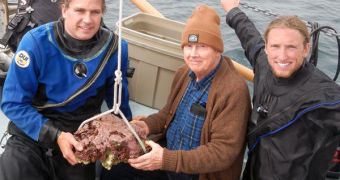Investigators from the University of Toronto Mississauga (UTM) announce that they were recently able to use crystalline sea floor algae to catch a glimpse of a small fraction of the Arctic Ocean's troubled history. By analyzing the calcite crust that was deposited between old layers of algae, the team was able to look 650 years back into the history of this ocean.
This is the first time that so-called algal tree rings were used to monitor and identify climate changes that have occurred in sea ices covering the Arctic. The main conclusion of the study was that the North Pole has lost an impressive volume of ice over the past 150 years or so.
For this research, UTM investigators worked closely with colleagues at the Smithsonian Institution, as well as from a number of universities in Germany and Newfoundland. The work was led by Jochen Halfar, who is an associate professor in the UTM Department of Chemical and Physical Sciences.
The group spent some time in the Arctic Ocean, collecting and analyzing samples from crystalline algae in the Clathromorphum compactum species. These plants live for relatively long periods of time, and form rock-like crusts made out of calcite on the sea floor once they die.
This makes it very easy for researchers to track back the chemical composition of the waters in which ancient generations of the algae grew. C. compactum produces the highest number of deposits at depths between 15 and 17 meters (49 to 56 feet), Science Daily reports.
“It's the same principle as using rings to determine a tree's age and the levels of precipitation. In addition to ring counting, we used radiocarbon dating to confirm the age of the algal layers,” says Halfar. Details of the study were published in Proceedings of the National Academy of Sciences.
The research team says that the rate at which these algae grow is determined by water temperatures, as well as by the amount of light that permeates to their depth. Therefore, these plants do not grow when the waters above them are covered with ices, such as during the winter.
In the spring, when sea ice melts, growth resumes. For this study, the team analyzed these cycles for a period of time spanning back around 650 years. “In the north, there is nothing in the shallow oceans that tells us about climate, water temperature or sea ice coverage on an annual basis,” explains Halfar.
“These algae, which live over a thousand years, can now provide us with that information,” the expert adds. His work was funded by the Natural Sciences and Engineering Research Council of Canada (NSERC) and Ecological Systems Technology.

 14 DAY TRIAL //
14 DAY TRIAL //